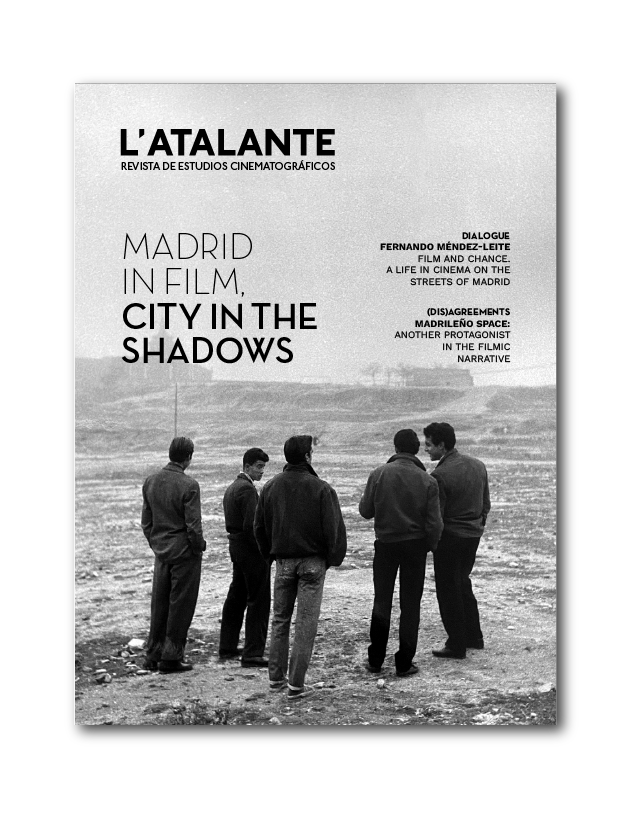Dissonances between delegated narrator and mega-narrator: four strategies for undermining the voice-over in 'The Virgin Suicides'
Published 2023-07-31
Keywords
- Narratology,
- Film studies,
- Voice-over,
- Film adaptations,
- Flashbacks
- Sofia Coppola ...More
How to Cite
Copyright (c) 2023 L'Atalante. Journal of film studies

This work is licensed under a Creative Commons Attribution-NonCommercial-NoDerivatives 4.0 International License.
Abstract
Since its release, The Virgin Suicides has attracted scholarly interest as a landmark work in contemporary American independent cinema and as an exceptional intersection of debates on roles, representations and conflicts from feminist and post-feminist perspectives. Although the book on which it is based has been the subject of extensive analysis related to the question of unreliable narration, this aspect has not been widely explored in the case of the film, whose expressive and formal mechanisms have not been effectively identified. This article offers a reading of the film in narratological terms with the aim of dissecting its discourse, with reference to two key concepts: the mega-narrator or great imaginer, who articulates the audiovisual narrative as a whole, and the delegated narrator, to whom the mega-narrator assigns the task of telling the story verbally. In contrast to voice-overs that act in lockstep with the representation of the diegetic world, in this film there is a dissonance between the former and the latter arising from four semantic vectors used by the mega-narrator to undermine the voice-over’s authority: stereotyping, irony, alienation, and decline. These four vectors also provide clues to the mystery of the story, despite the delegated narrator’s self-declared inability to solve it.
Downloads
References
- Abbot, M. (2018, 18 de abril). The Virgin Suicides: “They Hadn’t Heard Us Calling”. The Criterion Collection. Recuperado de https://www.criterion.com/current/posts/5573-the-virgin-suicides-they-hadn-t-heard-us-calling
- Backman Rogers, A. (2012). Ephemeral bodies and threshold creatures: The crisis of the adolescent rite of passage in Sofia Coppola’s ‘The Virgin Suicides’ and Gus Van Sant’s ‘Elephant’. NECSUS - European Journal of Media Studies, 1(1), 148-168.
- — (2015): American Independent Cinema: Rites of Passage and the Crisis Image. Edinburgh: Edinburgh University Press.
- — (2019): Sofia Coppola: The Politics of Visual Pleasure. New York, Oxford: Berghahn.
- Bolton, Lucy. (2011): Film and Female Consciousness: Irigaray, Cinema and Thinking Women. Basingstoke: Palgrave.
- Booth, W. (1983). The Rethoric of Fiction. Chicago: The University of Chicago Press.
- Cassetti, F., di Chio, F. (1991). Cómo analizar un film. Barcelona: Paidós.
- Chion, M. (2004): La voz en el cine. Madrid: Cátedra.
- Cook, P. (2021, 22 de octubre). Portrait of a lady: Sofia Coppola and Marie Antoinette. Recuperado de https://www.bfi.org.uk/sight-and-sound/features/portrait-of-a-lady-sofia-coppola-marie-antoinette
- Coppola, S. (2000). The Virgin Suicides: Screenplay. Paromount Classic.
- Dines, M. (2012). Suburban Gothic and the Ethnic Uncanny in Jeffrey Eugenides’s The Virgin Suicides. Journal of American Studies, 46(4), 959-975.
- Ferris, S. (2021). The Cinema of Sofia Coppola: Fashion, Culture, Celebrity. London and New York: Bloomsbury Academic.
- Garrido-Rodríguez, C. (2020). Repensando las olas del Feminismo. Una aproximación teórica a la metáfora de las “olas”. Revistas de Investigaciones Feministas 12(2), 483-492.
- Gaudreault, A., Jost, F. (1995). El relato cinematográfico. Barcelona: Paidós.
- Gevinson, T. (2013, 17 de junio). Girls With Power and Mystique: An Interview With Sofia Coppola. Recuperado de https://www.rookiemag.com/2013/06/sofia-coppola-interview/2/
- Gómez Tarín, F. J. (2013): El punto de vista en el audiovisual contemporáneo: una reformulación de conceptos enunciativos y narrativos. En M. Álvarez (ed.), Imágenes conscientes. AutorrepresentacioneS#2. Binges: Éditions Orbis Tertius, 27-45.
- Hirsch, T. (2020). Male nostalgia is a dead teenage girl. The romantic nostalgia of idealized traumatic female adolescence in Sofia Coppola’s The Virgin Suicides (Tesis de pregrado). Stockholm: Stockholm University.
- Hoskin, B. (2007). Playground Love: Landscape and Longing in Sofia Coppola’s The Virgin Suicides. Literature/Film Quarterly 35(3), 214-221.
- Kennedy, T. (2010). ‘Off with Hollywood’s Head’: Sofia Coppola as Feminine Auteur. Film Criticism 35(1), 37-59.
- — (2015). On the Road to ‘Some Place’: Sofia Coppola’s Dissident Modernism against a Postmodern Landscape. Miscelánea: A Journal of English and American Studies 52, 51-67.
- Kolker, R. (2000). A Cinema of Loneliness. Oxford and New York: Oxford University Press.
- Lin Tay, S. (2009). Women on the Edge: Twelve Political Film practice. Basingstoke: Palgrave Macmillan.
- Monden, M. (2013). Contemplating in a dream-like room: The Virgin Suicides and the aesthetic imagination of girlhood. Film, Fashion & Consumption, 2(2), 139-158. https://doi.org/10.1386/ffc.2.2.139_1
- Ortner, S. B. (2013). Not Hollywood: Independent Film at the Twilight of the American Dream. Durham: Duke University Press Books.
- Owens, B. (1973). Suburbia. San Francisco: Straight Arrow Books.
- Rimmon-Kenan, S. (1983). Narrative Fiction: Contemporary Poetics. New York: Methuen.
- Rogers, A. (2007). Sofia Coppola. Sense of Cinema, 45. Recuperado de http://www.sensesofcinema.com/2007/great-directors/sofia-coppola/
- Shostak, D. (2009). “A story we could live with”: Narrative Voice, the Reader, and Jeffrey Eugenides’s The Virgin Suicides. MFS Modern Fiction Studies, 55(4), 808-832. https://doi.org/10.1353/mfs.0.1642
- — (2013). “Impossible Narrative Voices”: Sofia Coppola’s Adaptation of Jeffrey Eugenides’s The Virgin Suicides. Interdisciplinary Literary Studies, 15(2), 180-202. https://doi.org/10.5325/intelitestud.15.2.0180
- Strong, H. (2022): “Sofia Coppola: Forever Young”. Abrams, New York: Little White Lies.
- Wyatt, J. (2018). The Virgin Suicides: Reverie, Sorrow and Young Love [EPUB]. London and New York: Routledge.
- Woodworth, A. (2010): A Feminist Theorization of Sofia Coppola’s Postfeminist Trilogy. En M. Block (ed.), Situating the Feminist Gaze and Spectatorship in Postwar Cinema. Newcastle: Cambridge Scholars Press, 27-45.

